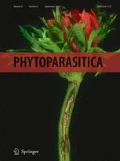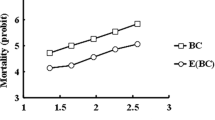Abstract
The development of insecticidal resistance in diamondback moth (DBM) Plutella xylostella has immediate implications for its management. In this study, we examined the mode of inheritance of Indoxacarb resistance in P. xylostella. The indoxacarb-resistant strain (Px-R) was obtained through continuous laboratory selection with increasing doses of indoxacarb in each generation. At the 14th generation of selection, the resistance ratio of Px-R strains was 238 over the susceptible strain (Px-S). The mode of inheritance to Indoxacarb in P. xylostella was examined performing standard reciprocal crosses between Px-R and Px-S and response of Px-R, Px-S and F1 hybrid progenies to Indoxacarb through leaf dip bioassay. The degree of dominance (D) and heritability (h) of F1 hybrid progeny ranged from −0.001 to 0.0012 and 0.499 to 0.506, respectively. The Indoxacarb resistance was appeared to be autosomal and inherited as a semi-dominant trait. The Px-R strain of P. xylostella showed little cross resistance to cypermethrin and there was no cross resistance to other pesticides viz., chlorpyrifos, spinosad, karanjin, xentari (Bta-Cry1C) and MVP-II (Cry1Ac). Since the Indoxacarb resistance inherited as a semi-dominant trait in P. xylostella, the sub lethal doses and frequent use of indoxacarb should be avoided for the management of P. xylostella. Moreover, Px-R of P. xylostella showed positive cross resistance to synthetic pyrethroids (cypemethrin), therefore indoxacarb and synthetic pyrethroids should not be recommended together for management of P. xylostella.
Similar content being viewed by others
References
Abbott, W. S. (1925). A method for computing the effectiveness of an insecticide. Journal of Economic Entomology, 18, 265–267.
Attique, M. N., Khaliq, R. A., & Sayyed, A. H. (2006). Could resistance to insecticides in Plutella xylostella (Lepidoptera: Plutellidae) be overcome by insecticides mixtures. Journal of Applied Entomology, 130(2), 122–127.
Bourguet, D., Genissel, A., & Raymond, M. (2000). Insecticide resistance and dominance levels. Journal of Economic Entomology, 93, 1588–1595.
Cao, G. C., & Han, Z. J. (2006). Tebufenozide resistance selected in Plutella xylostella and its cross-resistance and fitness cost. Pest Management Science, 62, 746–751.
Curtis, C. F. (1981). Possible methods of inhibiting or reversing the evolution of insecticide resistance in mosquitoes. Pesticide Science, 12, 557–564.
Dukare, A. S., Moharil, M. P., Ghodki, B. S., & Rao, N. G. V. (2009). Role of glutathione-s-transferase in imparting resistance to pyrethroids in Plutella xylostella (L.) International Journal of Integrative Biology, 6(1), 17.
Endersby, N. M., Mckenchie, S. W., Ridland, P. M., & Weeks, A. R. (2005). Microsatellites reveal a lack of structure in Australian populations of the diamondback moth, Plutella xylostella L. Molecular Ecology, 15, 107–108.
Finney, D. J. (Ed.). (1952). Probit analysis (p. 318). Cambridge: Cambridge University Press.
Firake, D. M., Lytan, D., & Behere, G. T. (2012a). Bio-diversity and seasonal activity of arthropod fauna in brassicaceous crop ecosystems of Meghalaya, North East India. Molecular Entomology, 3(4), 18–22.
Firake, D. M., Lytan, D., Behere, G. T., & Thakur, N. S. A. (2012b). Host plants alter the reproductive behavior of cabbage butterfly, Pieris brassicae (Lepidoptera: Pieridae) and its endo-larval parasitoid, Hyposoter ebeninus (Hymenoptera: Ichenuomonidae) in cruciferous ecosystems. Florida Entomologist, 95(4), 905–913.
Firake, D. M., Thubru, D. P., & Behere, G. T. (2017). Eco-toxicological risk and impact of pesticides on important parasitoids of cabbage butterflies in cruciferous ecosystem. Chemosphere, 168, 372–383.
Furlong, M. J., Wright, D. J., & Dosdall, L. M. (2013). Diamondback moth ecology and management: Problems progress and prospects. Annual Review of Entomology, 58(1), 517–541.
Jiang, D., Du, Y., Nomura, Y., Wang, X., Wu, Y., Zhorov, B. S., & Dong, K. (2015). Mutations in the transmembrane helix S6 of domain IV confer cockroach sodium channel resistance to sodium channel blocker insecticides and local anesthetics. Insect Biochemistry and Molecular Biology, 66, 88–95. https://doi.org/10.1016/j.ibmb.2015.09.011.
Kranthi, K. R., Dhawad, C. S., Naidu, S. R., Mate, K., Behere, G. T., Wadaskar, R. M., & Kranthi, S. (2006). Inheritance of resistance in Indian Helicoverpa armigera (Hubner) to Cry1Ac toxin of Bacillus thuringiensis. Crop Protection, 25, 119–124.
Liu, T. X., Alton, S., & Chen, W. (2003). Toxicity, persistence and efficacy of indoxacarb and two other insecticides on Plutella xylostella (Lepidoptera: Plutellidae) immatures in cabbage. International Journal of Pest Management, 49(3), 235–241.
Mohan, M., & Gujar, G. T. (2003). Local variation in susceptibility of the diamondback moth, Plutella xylostella(L.) to insecticides and role of detoxification enzymes. Crop Protection, 22(3), 495–504.
Nehare, S., Ghodki, B. S., Lande, G. K., Pawade, V., & Thakare, A. S. (2010). Inheritance of resistance and cross resistance pattern in inoxacarb-resistant diamondback moth Plutella xylostella L. Entomological Research, 40(1), 18–25.
Noppun, V., Miyata, T., & Saito, T. (1986). Laboratory selection for resistance with phenthaote and fenvalerate in the diamondback moth Plutella xylostella (Lepidoptera: Yponomeutidae). Crop Protection, 5, 323–327.
Perng, F. S., Yao, M. C., Hung, C. F., & Sun, C. N. (1988). Teflubenzuron resistance in diamondback moth (Lepidoptera: Plutellidae). Journal of Economic Entomology, 81(5), 1277–1282.
Qian, L., Cao, G. C., Song, J. X., Yin, Q., & Han, Z. J. (2008). Biochemical mechanisms conferring cross-resistance between tebufenozide and abamectin in Plutella xylostella L. Pesticide Biochemistry and Physiology, 91, 175–179.
Russell, R. M., Robertson, J. L., & Savin, N. E. (1977). POLO: A new computer program for probit analysis. Bulletin of the Entomological Society of America, 23, 209–213.
Sayyed, A. H., & Wright, D. J. (2001). Fitness costs and stability of resistance to Bacillus thuringiensis in a field population of the diamondback moth Plutella xylostella L. Ecological Entomology, 26, 502–508.
Sayyed, A. H., & Wright, D. J. (2004). Fipronil resistance in the diamondback moth (Lepidoptera: Plutellidae): inheritance and number of genes involved. Journal of Economic Entomology, 97(6), 2043–2050.
Sayyed, A. H., & Wright, D. J. (2006). Genetics and evidence for an esterase-associated mechanism of resistance to indoxacarb in a field population of diamondback moth (Lepidoptera: Plutellidae). Pest Management Science, 62, 1045–1051.
Sayyed, A. H., Ferre, J., & Wright, D. J. (2000). Mode of inheritance and stability of resistance to Bacillus thuringiensis varkurstaki in a diamondback moth (Plutella xylostella) population from Malaysia. Pest Management Science, 56, 743–748.
Sayyed, A. H., Omar, D., & Wright, D. J. (2004). Genetics of spinosad resistance in a multi-resistant field selected population of Plutella xylostella. Pest Management Science, 60, 827–832.
Sayyed, A. H., Attique, M. N., Khaliq, A., & Wright, D. J. (2005). Inheritance of resistance and cross resistance to deltamethrin in Plutella xylostella (Lepidoptera: Plutellidae) from Pakistan. Pest Management Science, 61(7), 636–642.
Shi, J., Zhang, L., & Gao, X. (2011). Characterization of spinosad resistance in the housefly Musca domestica (Diptera: Muscidae). Pest Management Science, 67, 335–340.
Shono, T., Zhang, L., & Scott, J. G. (2004). Indoxacarb resistance in the house fly, Musca domestica. Pesticide Biochemistry and Physiology, 80, 106–112.
Sun, C. N., Wu, T. K., Chen, J. S., & Lee, W. T. (1986). Insecticide resistance in diamondback moth. In N. S. Talekar & T. D. Griggs (Eds.), Diamondback Moth Management: Proceeding of 1st International Workshop (pp. 359–371). Shanhua: AVRDC.
Tabashnik, B. E., & Cushing, N. L. (1987). Leaf residue Vs tropical bioassays for assessing insecticide resistance in the diamondback moth, P. xylostella L. DAO Plant Protection Bulletin, 35, 11–14.
Tabashnik, B. E., Cushing, N. L., Finson, N., & Johnson, M. W. (1990). Field development of resistance to Bacillus thuringiensis in diamondback moth (Lepidoptera: Plutellidae). Journal of Economic Entomology, 83, 1671–1676.
Tabashnik, B. E., Gassmann, A. J., Crowder, D. W., & Carriere, Y. (2008). Insect resistance to Bt crops: evidence versus theory. Nature Biotechnology, 26, 199–202.
Talekar, N. S., & Shelton, A. M. (1993). Biology ecology and management of the diamondback moth. Annual Review of Entomology, 38, 275–301.
Verkerk, R. H. J., & Wright, D. J. (1993). Biological activity of neem seed kernel extracts and of synthetic azadirachtin against larvae of Plutella xylostella L. Pesticide Science, 37, 83–91.
Wang, X. L., Su, W., Zhang, J. H., Yang, Y. H., Dong, K., & Wu, Y. D. (2016). Two novel sodium channel mutations associated with resistance to indoxacarb and metaflumizone in the diamondback moth, Plutella xylostella. Insect Science, 23, 50–58. https://doi.org/10.1111/1744-7917.12226.
Wright, D. (2004). Biological control of DBM: a global perspective. In: D. Bordat, A. A. Kirk (Eds.), Improving biocontrol of Plutella xylostella. Proceedings of the International Symposium in Montpellier. CIRAD, Montpellier. ISBN 2-87614 570 7, pp. 9–14. Oct 21–24, 2002.
Yu, S. J., & McCord, E. (2007). Lack of cross resistance to Indoxacarb ininsecticide resistant Spodoptera frugiperda (Lepidoptera: Noctuidae)and Plutella xylostella (Lepidoptera: Yponomeutidae). Pest Management Science, 63, 63–67.
Zhao, J. Z., Collins, H. L., Tang, J. D., Cao, J., Earle, E. D., Roush, R. T., Herrero, S., Escriche, B., Ferre, J., & Shelton, A. M. (2000). Development and characterization of diamondback moth resistance to transgenic broccoli expressing high levels of Cry1C. Applied and Environmental Microbiology, 66, 3784–3789.
Zhao, J. Z., Li, Y. X., Collins, H. L., Gusukuma-Minuto, L., Mau, R. F. L., Thompson, G. D., & Shelton, A. M. (2002). Monitoring and characterization of diamondback mothresistance to spinosad. Journal of Economic Entomology, 95, 430–436.
Zhao, J. Z., Collins, H. L., Li, Y. X., Mau, R. F. L., Thompson, G. D., Hertlein, M., Andaloro, J. T., Boykin, R., & Shelton, A. M. (2006). Monitoring of diamondback moth (Lepidoptera: Plutellidae) resistance to spinosad, indoxacarb, and emamectin benzoate. Journal of Economic Entomology, 99, 176–181.
Acknowledgements
This manuscript is the part of the M.Sc. thesis of the first author, submitted to the College of Post-Graduate Studies (CAU) Umiam, Meghalaya and also the part of institute funded project “ Bio-rational management of major insect pests of vegetables (PIMS code: IXX04744)”. The authors are thankful to the Director, ICAR Research Complex for NEH Region, Umiam, Meghalaya for providing necessary facilities for this study. The authors are also grateful to the student advisory committee members for critical advice during the study.
Author information
Authors and Affiliations
Corresponding author
Ethics declarations
Conflict of interest
The authors declare that they have no conflict of interest.
Rights and permissions
About this article
Cite this article
Marak, R.M., Firake, D.M., Sontakke, P.P. et al. Mode of inheritance of Indoxacarb resistance in diamondback moth, Plutella xylostella (L.) and cross resistance to different groups of pesticides. Phytoparasitica 45, 549–558 (2017). https://doi.org/10.1007/s12600-017-0618-6
Received:
Accepted:
Published:
Issue Date:
DOI: https://doi.org/10.1007/s12600-017-0618-6




